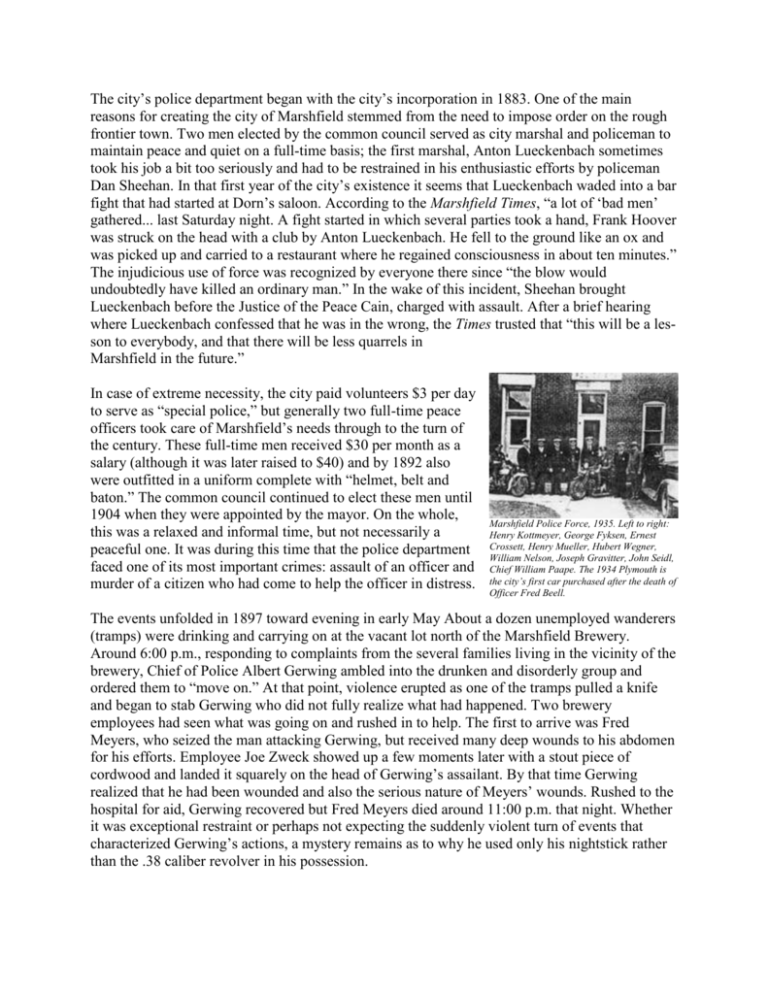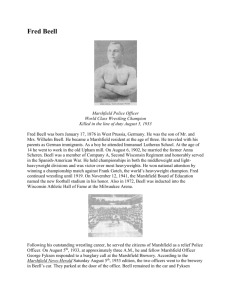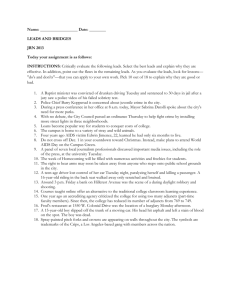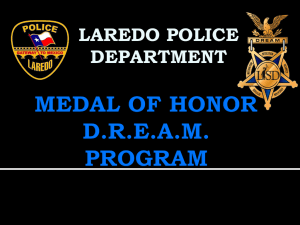History - City of Marshfield
advertisement

The city’s police department began with the city’s incorporation in 1883. One of the main reasons for creating the city of Marshfield stemmed from the need to impose order on the rough frontier town. Two men elected by the common council served as city marshal and policeman to maintain peace and quiet on a full-time basis; the first marshal, Anton Lueckenbach sometimes took his job a bit too seriously and had to be restrained in his enthusiastic efforts by policeman Dan Sheehan. In that first year of the city’s existence it seems that Lueckenbach waded into a bar fight that had started at Dorn’s saloon. According to the Marshfield Times, “a lot of ‘bad men’ gathered... last Saturday night. A fight started in which several parties took a hand, Frank Hoover was struck on the head with a club by Anton Lueckenbach. He fell to the ground like an ox and was picked up and carried to a restaurant where he regained consciousness in about ten minutes.” The injudicious use of force was recognized by everyone there since “the blow would undoubtedly have killed an ordinary man.” In the wake of this incident, Sheehan brought Lueckenbach before the Justice of the Peace Cain, charged with assault. After a brief hearing where Lueckenbach confessed that he was in the wrong, the Times trusted that “this will be a lesson to everybody, and that there will be less quarrels in Marshfield in the future.” In case of extreme necessity, the city paid volunteers $3 per day to serve as “special police,” but generally two full-time peace officers took care of Marshfield’s needs through to the turn of the century. These full-time men received $30 per month as a salary (although it was later raised to $40) and by 1892 also were outfitted in a uniform complete with “helmet, belt and baton.” The common council continued to elect these men until 1904 when they were appointed by the mayor. On the whole, this was a relaxed and informal time, but not necessarily a peaceful one. It was during this time that the police department faced one of its most important crimes: assault of an officer and murder of a citizen who had come to help the officer in distress. Marshfield Police Force, 1935. Left to right: Henry Kottmeyer, George Fyksen, Ernest Crossett, Henry Mueller, Hubert Wegner, William Nelson, Joseph Gravitter, John Seidl, Chief William Paape. The 1934 Plymouth is the city’s first car purchased after the death of Officer Fred Beell. The events unfolded in 1897 toward evening in early May About a dozen unemployed wanderers (tramps) were drinking and carrying on at the vacant lot north of the Marshfield Brewery. Around 6:00 p.m., responding to complaints from the several families living in the vicinity of the brewery, Chief of Police Albert Gerwing ambled into the drunken and disorderly group and ordered them to “move on.” At that point, violence erupted as one of the tramps pulled a knife and began to stab Gerwing who did not fully realize what had happened. Two brewery employees had seen what was going on and rushed in to help. The first to arrive was Fred Meyers, who seized the man attacking Gerwing, but received many deep wounds to his abdomen for his efforts. Employee Joe Zweck showed up a few moments later with a stout piece of cordwood and landed it squarely on the head of Gerwing’s assailant. By that time Gerwing realized that he had been wounded and also the serious nature of Meyers’ wounds. Rushed to the hospital for aid, Gerwing recovered but Fred Meyers died around 11:00 p.m. that night. Whether it was exceptional restraint or perhaps not expecting the suddenly violent turn of events that characterized Gerwing’s actions, a mystery remains as to why he used only his nightstick rather than the .38 caliber revolver in his possession. There is little of exceptional note in the police department’s story after the turn of the century except an orderly growth of personnel and resources at their disposal. Reporting crime and getting a quicker response came with installation of the city’s first call box in 1902 and then the creation of three new positions in 1904. Full-time and professional men were required with continued reliance upon the qualified service of voluntary Marshfield Police Department, 1994. “special police.” It is interesting to note that much of the local (reprinted with permission of Robert Pue demands on the police in this early period centered on Photography) enforcement of civil codes— minor, non-criminal violations— rather than serious life threatening crime. In the city’s first annual police report filed in 1907, the Chief of Police Albert Gerwing, noted that there had been 89 arrests made in the city! However, the amount of fines garnered from these arrests revealed the nature of the offenses: $44 went to the city coffers while the vast majority. $194 went into the state treasury. Additionally, the city jail, while not the Waldorf Astoria and criticized by state inspectors as lacking sufficient ventilation, paint and washing facilities, did provide “free lodging” to 223 men that year. In the absence of any local relief, a night in jail may have been the best way for an unemployed person to survive a cold winter’s eve or, as likely, to sleep off a binge after payday. Recognizing the police department as a permanent and vital addition to the city came in 1909. Under a special provision in state law, cities the size of Marshfield were granted the right to establish a Police and Fire Commission as an official governmental body. Its members were appointed by the mayor, which spoke of that body’s importance to the executive branch of municipal government but more significantly; the affiliation with the fire department signaled the police’s growing role in protecting the residents. The 1887 blaze revolutionized fire fighting in the city, from the building codes that governed construction along Central Avenue to the increased efficiency of the water and light department. Creating the police and fire commission meant that the city’s law enforcement agency had come of age. Throughout the 1920s, traffic fines, illegal alcohol and the occasional quarantine occupied the police department’s time. Keeping the hobo jungles cleared of undesirable men took on additional importance during the Depression as the numbers increased steadily through the early 1930s. While some tramps were people simply down on their luck, others were professional criminals who traveled the road to rob. It was during this time that the city lost its only policeman in the line of duty, Fred Beell, an auxiliary policeman who interrupted a robbery at the brewery and was gunned down for his service. Beell had come to the end of an extraordinary career as an exceptionally talented, honest, and clean-living professional wrestler whose undefeated career took him around the world. Shortly after the brewery reopened with Prohibition’s demise, it was targeted by a gang out to steal the valuable federal government revenue stamps in the company’s vault. While the Beell story has been told in the narrative portion of the history, it is worth mentioning again here because it serves to remind us that any officer at any time may be asked to make the ultimate sacrifice for the protection of the community. What seems to be a routine traffic stop or casual investigation may end in violence. Without the police protection afforded by professional and volunteer alike, the growth and development of Marshfie1d would not have come about in the past 125 years. The next major change to affect the department came in 1947 under the leadership of Police Chief Walter Wohlfahrt. During his service, the police were enabled to communicate immediately with one another and the station via radio transmissions and were better equipped to look for long-term patterns in events by instituting a record keeping system still in use today. The need for keeping those records, along with a wide variety of evidence and to carry on investigations prompted the department to move to larger quarters in 1961. The police occupied remodeled space the fire department vacated when they went to the new East Fourth Street station. Over the years, the police department grew to encompass 47 members by 1972. The department’s needs could no longer be met by their location in the old city hall, so it was with great pride and relief that a new building went up at the corner of West Depot and South Chestnut Streets in 1982. The new structure was designed with security in mind, security for both the officers and the community they serve. At the dedication, more than 1,000 people toured the building and attended the dedication by Mayor Marilyn Hardacre. The new complex solved a number of persistent problems by providing space for evidence, private interviews and limited public access to suspects being brought into the station for detention. Generally, the new organizational layout permitted the most effective use of manpower possible. The entire ceremony was capped off by presentation to the department of a plaque commemorating Fred Beell’s induction into the Wisconsin Hall of Fame. Today, the department has 40 full-time police officers, 2 ordinance/humane officers, 6 support staff, 15 part-time crossing guards, 24 volunteer auxiliary police, one park patrol officer, and 4 chaplains. From the very modest beginnings of one marshal and one policeman needed to curb frontier rowdiness in 1883, the police department has expanded to keep pace with the demands of a modern city. Marshfield Police Department, 1963. (Left to right, back row): Robert Woytasik, Mickey Bell, Clarence Reisncr, Marion Jahr, Pat Madden, Chief Walter Wohlfahrt, Joe Altmann, Al Pautzke, Ray Blanchard, Walt Yokmkus, Dave Deitchman, Fred Bartsch, Jerry Thieme, Bill Wohlfarht, Ray Schmidt and Rod Franke. (Front row): Walt Kuhn, Bill Jahnke. Erv Schiebe, Lloyd Burt, Dick Blackburn, Lavern “Ted” Reigel, Terry Rhodes, Bob Grayes, Leroy Shillinger and Jim Hanson.









